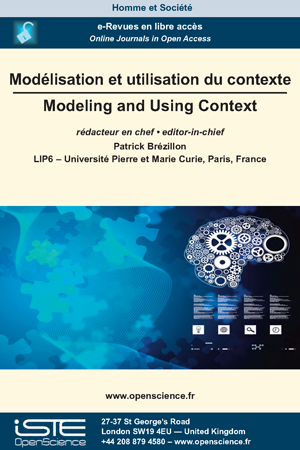

Social Sciences and Humanities > Home > Modeling and Using Context > Issue
This paper presents and discusses how context is being used to model intelligent human activity –
specifically, tactical actions. Tactical behavior involves selection and execution of courses of action that address the current needs of the agent. The discussion centers about the work done in the author’s research laboratory that addresses tactical behavior by an agent. A limited discussion about the works of others is also included. Two points of view are discussed vis-à-vis the tactical behavior of an agent: a) from the point of view of a performer of an action (the doer), and b) from the standpoint of one who directs others (agents or humans) to perform the actions (a manager, commander or coach). Additionally, the role that can be played by context in machine learning of tactical behavior is also discussed. This particularly focuses on learning from observation of human performance, known as LfO. LfO has been found to be an effective way for learning agents to learn how to perform certain tasks that are performed by a human and whose actions are observed (i.e., recorded in a time-stamped trace of what actions were taken when).
The paper presents the current status of research on context modeling and management that emerges from several real-world applications since 25 years. We now have a robust conceptual framework and its implementation as a piece of software called Contextual-Graphs (CxG) platform. The context modeling and management were limited to few relevant aspects of context in each application. Working on several applications imposed to develop a robust conceptual
framework and software that are independent of applications. The CxG formalism is the syntax and the domain models are the semantics. The CxG formalism relies on four elements (action, contextual element, activity and executive structure of independent activities) and about 200 models were developed as contextual graphs. This success comes from the fact that the CxG formalism is used for modeling human behaviors during task realization, not task models. The
robustness of the CxG formalism offers challenging perspectives in crucial domains like weak-signal management in emergency rooms or crisis or security problems.
All effective agents are context-sensitive. This is true for biological agents, and it must also be true for artificial agents if they are to succeed. Context-mediated behavior (CMB) is one approach to endowing artificial agents with context-sensitive, context-appropriate behavior. It relies on explicitly representing contexts – important classes of situations – as contextual schemas and associating with them all the relevant knowledge about that context. The agent
can then use these c-schemas to assess its context and their knowledge to behave appropriately. In this paper, we provide an overview of CMB, review the past work on it, discuss what we have learned from more than twenty years of working on the problem, and describe where we are and where we are going with CMB.
Business Process Management (BPM) is the art and science of monitoring how the work is performed within an organization to ensure consistent results and opportunities for improvement. One important research topic on BPM relates to the issue of flexibility. Unplanned conditions may occur at any time during process execution. In dynamic environments, changes must be performed more frequently and systematically and considering not only pre-established rules, but also contextual information. The literature indicates context as a source of information that should be considered in the modeling of business processes in order to contribute to their flexibility when in the execution phase. In this paper, we present the results from our studies about context in the whole cycle of BPM. The goal is to describe an approach that comprises solutions for modeling, gathering, using and evolving context in a BPM oriented environment.

2021
Volume 21- 4
CONTEXT-21 Special Issue2019
Volume 19- 3
Issue 12018
Volume 18- 2
Issue 12017
Volume 17- 1
Issue 1